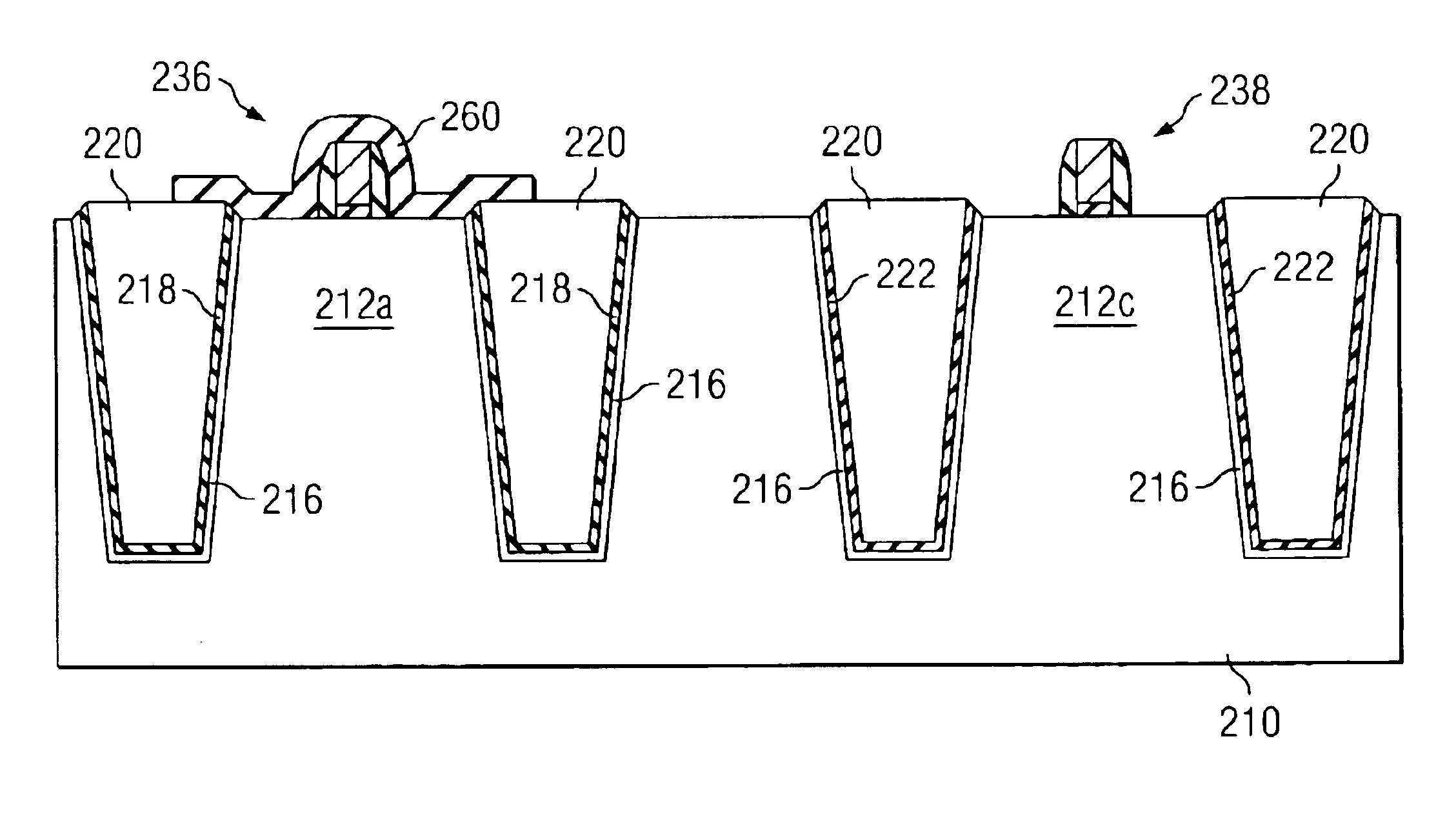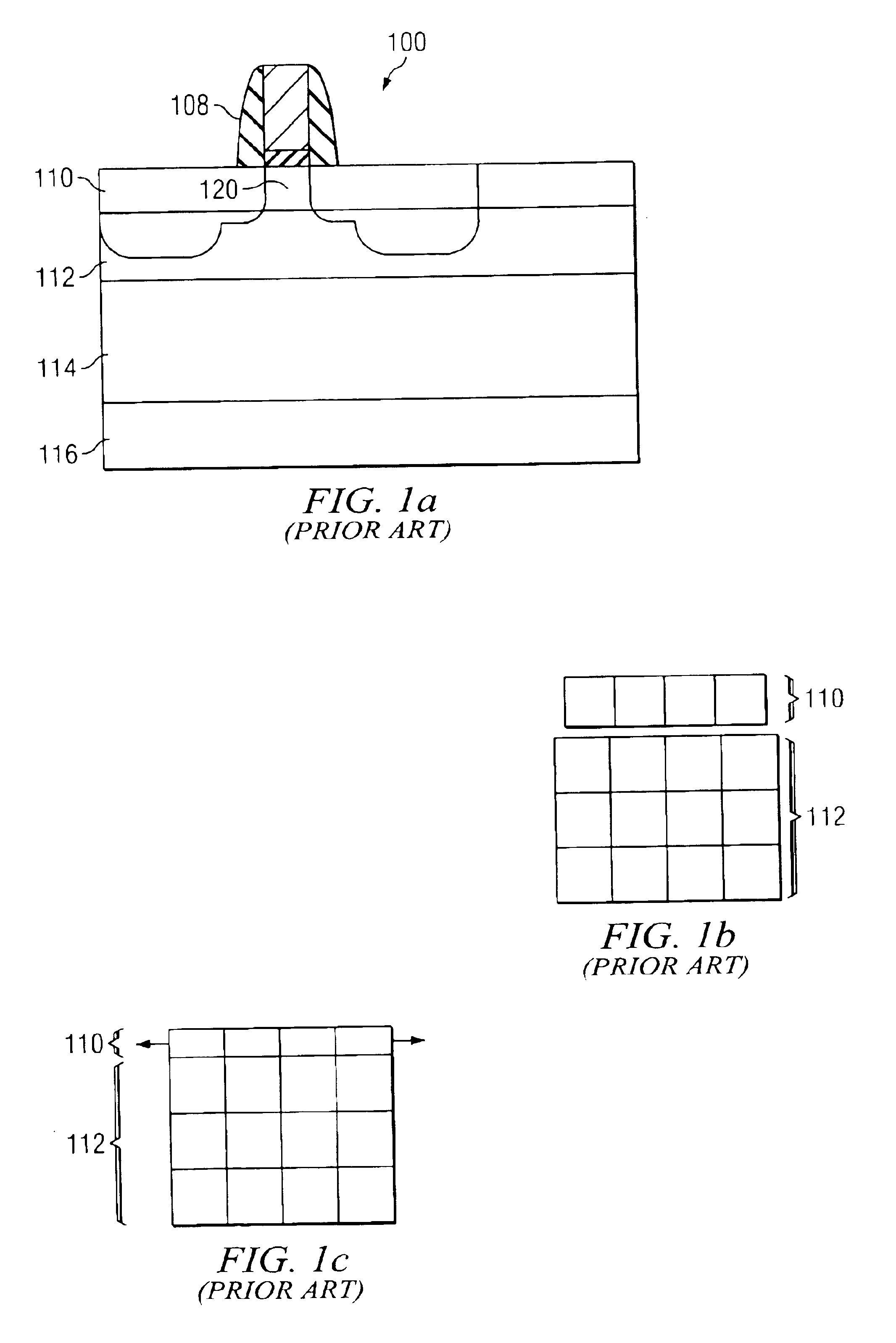Strained-channel transistor and methods of manufacture
a strain-channel transistor and manufacturing method technology, applied in the direction of transistors, semiconductor devices, electrical apparatus, etc., can solve the problems of high defect density of substrates, high approach cost, and strain relaxation, and achieve the effect of improving the performance of both n-channel and p-channel transistors
- Summary
- Abstract
- Description
- Claims
- Application Information
AI Technical Summary
Benefits of technology
Problems solved by technology
Method used
Image
Examples
first embodiment
[0037]As shown in FIGS. 4a and 4b, a second isolation structure 214c / d is employed to define a second active region 212c, which will be provided with in-plane compressive strain. In a first embodiment, as shown in FIG. 4a, the second isolation structure 214c / d is a trench isolation structure with a silicon oxide liner 216 underlying an ion-implanted silicon nitride liner 222. The ion implantation introduces defects into the silicon nitride liner film 222 and causes it to lose or degrades its ability to block oxygen diffusion. Therefore, it is possible for oxygen to diffuse through silicon nitride 222 and result in further oxidation of the trench sidewall, causing volume expansion in a confined space, and therefore introducing in-plane compressive stress in the second active region.
[0038]The in-plane compressive stress results in an in-plane compressive strain in the crystal lattice of the material comprising the second active region 212c. It is desired that this in-plane compressive...
second embodiment
[0039]In a second embodiment, as shown in FIG. 4b, the second isolation structure 214c / d is a conventional trench isolation structure with a silicon oxide liner (not shown) and with no silicon nitride liner. The second isolation structure resembles the isolation structure of FIG. 3a and therefore results in an in-plane compressive strain in the second active region.
[0040]According to the preferred embodiment of the present invention, the first and second active regions 212a and 212c are provided on the same semiconductor substrate 210. By having the flexibility of providing active regions with different strain conditions, it is therefore possible to optimize the performance of n-channel and p-channel transistors by the choice and use of the appropriate strain conditions in the active regions. For example, n-channel transistors (not shown in FIG. 4) may be formed on the first active region 212a with tensile strain in their source-to-drain direction to improve their drive current perf...
third embodiment
[0068]In the third embodiment method, another process flow is provided for forming active regions with different strain conditions. The starting material is a semiconductor substrate as shown in FIG. 8a. Trenches 232 are formed in the semiconductor substrate 210 using a first mask 230, as shown in FIG. 8b. A liner oxide 216, such as thermally grown silicon oxide, is then formed on at least the sidewalls of the trenches, as shown in FIG. 8c. It is understood that the liner oxide may also be formed by deposition techniques.
[0069]A second patterned mask 235 is formed to cover the second active region 212c, while exposing the first active region 212a, as shown in FIG. 8d. The mask 235 may cover all or a portion of the trenches 232. Liner oxide 216 not covered by the second patterned mask may be nitrided. The nitridation process forms a nitrided liner 217 and may include an ion implantation of nitrogen containing species, an anneal in a nitrogen-containing ambient, or exposure to nitroge...
PUM
 Login to View More
Login to View More Abstract
Description
Claims
Application Information
 Login to View More
Login to View More - Generate Ideas
- Intellectual Property
- Life Sciences
- Materials
- Tech Scout
- Unparalleled Data Quality
- Higher Quality Content
- 60% Fewer Hallucinations
Browse by: Latest US Patents, China's latest patents, Technical Efficacy Thesaurus, Application Domain, Technology Topic, Popular Technical Reports.
© 2025 PatSnap. All rights reserved.Legal|Privacy policy|Modern Slavery Act Transparency Statement|Sitemap|About US| Contact US: help@patsnap.com



